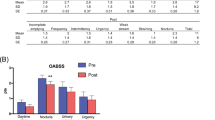Abstract
Prostatectomy for benign hypertrophy of the prostate is usually performed to alleviate lower urinary tract symptoms (LUTS). We assessed indications for and risks of prostatectomy in men 80 years of age and compared them to those for younger men in order to determine whether indications for prostatectomy in octogenarians are different than these for younger men. Medical records of 171 men comprised of 84 patients >80 years of age (mean 84.4) and 87 patients <65 years of age (mean 60.6) who underwent prostatectomy for benign prostate hypertrophy were reviewed. Data regarding indications for surgery, American Society of Anesthesiologists system grade, anesthesia and surgery performed, duration of hospitalization and intrahospital postoperative complications were obtained. The respective indications for surgery in the very elderly and younger patients were: urinary retention with indwelling catheter in 46 (55%) and 34 (39%) (p < 0.04), LUTS in 32 (38%) and 52 (59%) (p < 0.005), and gross hematuria in 6 (7%) and 1 (1.2%). Transurethral prostatectomy was performed in 47 elderly patients (56%) and in 30 young patients (34.5%). The other patients in each group underwent open (suprapubic prostatectomy) surgery. The overall complication rate was significantly higher in the elderly group (39% vs 22%, p < 0.05), with major complications occurring only in this group. Indications for surgery were different for octogenarians than for younger men. Morbidity and mortality rates were significantly higher among the elderly men. Age appears to be an independent risk factor for complications associated with prostatectomy.
Similar content being viewed by others
References
Kirby RS. The natural history of benign prostatic hyperplasia: what have we learned in the last decade? Urology 2000; 56(5 Suppl 1): 3–6.
Mebust WK, Holtgrewe HL, Cockett AT, Peters PC. Transurethral prostatectomy: immediate and postoperative complications. A cooperative study of 13 participating institutions evaluating 3,885 patients. J Urol 1989; 141: 243–247.
Reid BC, Alberg AJ, Klassen AC et al. The American Society of Anesthesiologists' class as a comorbidity index in a cohort of head and neck cancer surgical patients. Head Neck 2001; 23: 985–994.
Baine WB, Yu W, Summe JP, Weis KA. Epidemiologic trends in the evaluation and treatment of lower urinary tract symptoms in elderly male Medicare patients from 1991 to 1995. J Urol 1998; 160: 816–820.
Hollander JB, Diokno AC. Prostatism: benign prostatic hyperplasia. Urol Clin North Am 1996; 23: 75–86.
Burney TL, Badlani GH. Anesthetic considerations in the geriatric patient. Urol Clin North Am 1996; 23: 19–26.
Luttwak Z, Lask D, Abarbanel J et al. Transvesical prostatectomy in elderly patients. J Urol 1997; 157: 2210–2211.
Bellomo R, Goldsmith D, Russell S, Uchino S. Postoperative serious adverse events in a teaching hospital: a prospective study. Med J Aust 2002; 176: 216–218.
Author information
Authors and Affiliations
Corresponding author
Rights and permissions
About this article
Cite this article
Nadu, A., Mabjeesh, N.J., Ben-Chaim, J. et al. Are indications for prostatectomy in octogenarians the same as for younger men?. Int Urol Nephrol 36, 47–50 (2003). https://doi.org/10.1023/B:UROL.0000032683.36827.63
Issue Date:
DOI: https://doi.org/10.1023/B:UROL.0000032683.36827.63




